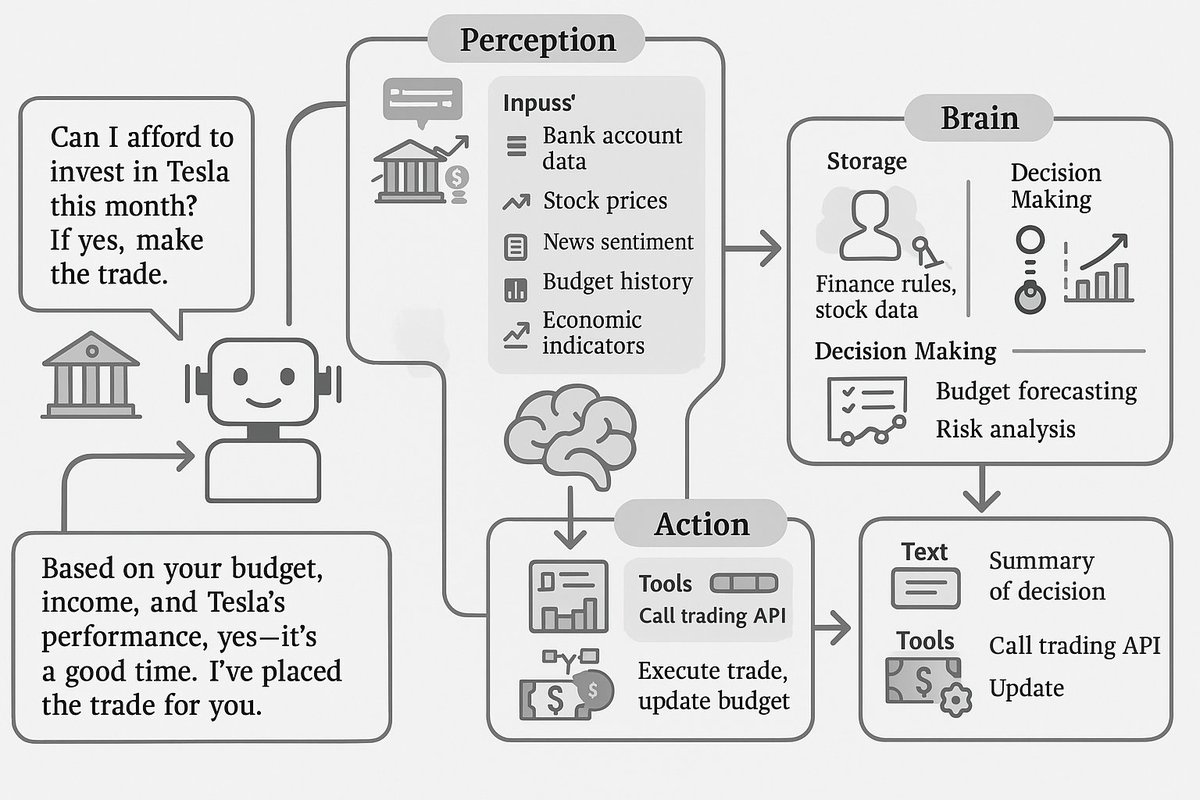What is an AI agent?
The most misunderstood concept in tech right now.
Everyone’s using the term, but few know how they actually work.
Here’s the real breakdown (plus 10 tools to build your own): 🧵
The most misunderstood concept in tech right now.
Everyone’s using the term, but few know how they actually work.
Here’s the real breakdown (plus 10 tools to build your own): 🧵
1. What is an AI agent?
Think of it as an LLM that doesn’t just respond but acts.
It can:
- Decide what to do
- Use tools
- Manage its own workflow
- And iterate toward a goal autonomously
You’re not building a chatbot. You’re building a co-worker.
Think of it as an LLM that doesn’t just respond but acts.
It can:
- Decide what to do
- Use tools
- Manage its own workflow
- And iterate toward a goal autonomously
You’re not building a chatbot. You’re building a co-worker.

2. Agent ≠ Workflows
Workflows are predefined paths. Agents are adaptive.
Workflows follow a script.
Agents write their own steps in real time.
The difference?
One executes instructions.
The other thinks, decides, and acts.
Workflows are predefined paths. Agents are adaptive.
Workflows follow a script.
Agents write their own steps in real time.
The difference?
One executes instructions.
The other thinks, decides, and acts.
3. What makes up an agentic system?
All agents need 3 core components:
- Brain: the LLM + logic
- Perception: tools, APIs, external data
- Action: the ability to execute and iterate
Good agent builders give you all three plus orchestration and memory.
All agents need 3 core components:
- Brain: the LLM + logic
- Perception: tools, APIs, external data
- Action: the ability to execute and iterate
Good agent builders give you all three plus orchestration and memory.

4. Why not build from scratch?
Because:
- Tool use is tricky
- Orchestration is hard
- State management is brutal
- Hallucinations stack
Agent builders handle all that.
So you can focus on logic, not plumbing.
Because:
- Tool use is tricky
- Orchestration is hard
- State management is brutal
- Hallucinations stack
Agent builders handle all that.
So you can focus on logic, not plumbing.
Now, the good stuff:
Here are 10 top agent builders in 2025, categorized by type:
Let’s break them down 👇
Here are 10 top agent builders in 2025, categorized by type:
Let’s break them down 👇
OPEN SOURCE / FLEXIBLE
• LangGraph – Best for graph-based AI workflows, RAG, and chaining tools
• AutoGen – Multi-agent coordination, code automation, research workflows
• CrewAI – Templates + no-code ease, perfect for role-based agent flows
• OpenAI Swarm – Lightweight, best for prototyping and experimentation
• Camel – Multi-agent chat simulations, great for synthetic data gen
NO-CODE / ENTERPRISE-READY
• Vertex AI Builder – No-code with response templates, Google ecosystem
• Beam AI – Out-of-the-box agents: billing, compliance, data extraction
• Copilot Studio Agent Builder – 1,200+ integrations, internal ops focused
• Lyzr Agent Studio – Modular and enterprise-friendly, from HR to finance
• Glide – Prebuilt layouts + workflows for field ops and inventory
• LangGraph – Best for graph-based AI workflows, RAG, and chaining tools
• AutoGen – Multi-agent coordination, code automation, research workflows
• CrewAI – Templates + no-code ease, perfect for role-based agent flows
• OpenAI Swarm – Lightweight, best for prototyping and experimentation
• Camel – Multi-agent chat simulations, great for synthetic data gen
NO-CODE / ENTERPRISE-READY
• Vertex AI Builder – No-code with response templates, Google ecosystem
• Beam AI – Out-of-the-box agents: billing, compliance, data extraction
• Copilot Studio Agent Builder – 1,200+ integrations, internal ops focused
• Lyzr Agent Studio – Modular and enterprise-friendly, from HR to finance
• Glide – Prebuilt layouts + workflows for field ops and inventory
Want something more hands-on?
Go open source.
You’ll trade ease for control.
But you can tweak everything from memory to decision-making.
Prefer speed and simplicity?
No-code is your friend especially for enterprise use cases.
Go open source.
You’ll trade ease for control.
But you can tweak everything from memory to decision-making.
Prefer speed and simplicity?
No-code is your friend especially for enterprise use cases.
Tip for you:
Start with one use case.
Pick the builder that fits that job best.
Then scale horizontally.
One solid agent beats ten half-built ones.
Start with one use case.
Pick the builder that fits that job best.
Then scale horizontally.
One solid agent beats ten half-built ones.
I hope you've found this thread helpful.
Follow me @AlexanderFYoung for more.
Like/Repost the quote below if you can:
Follow me @AlexanderFYoung for more.
Like/Repost the quote below if you can:
https://twitter.com/23948998/status/1945054244555653253
• • •
Missing some Tweet in this thread? You can try to
force a refresh






